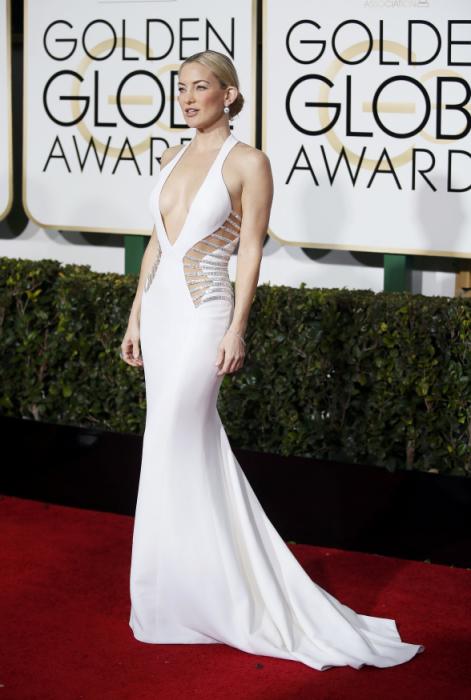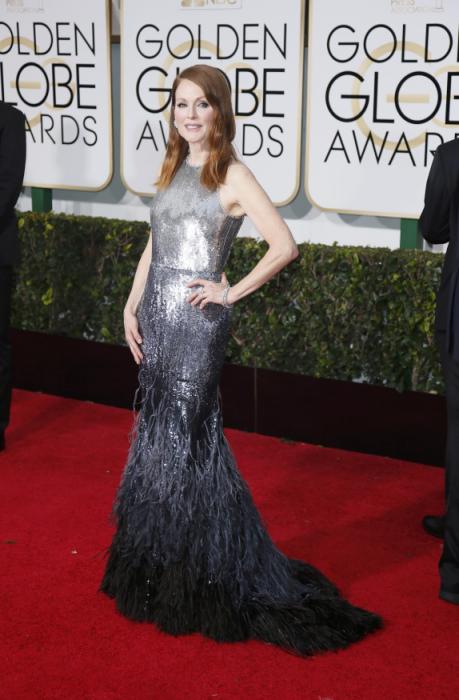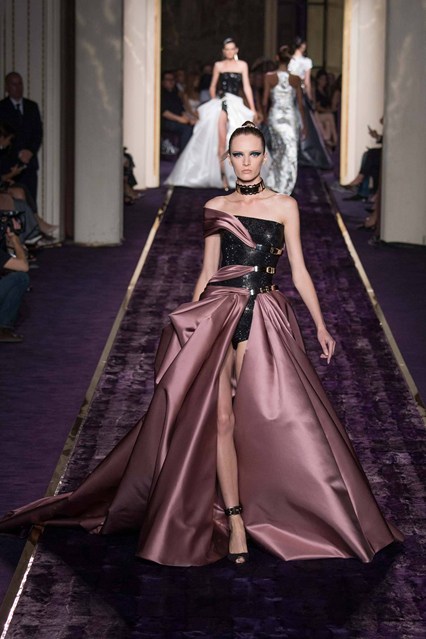There are some Oscar years where the defining mood is hard to pin down – but 2015 was the year where indefinability was exactly the point. No-one wanted to be limited or censored, and the prevailing spirit of the awards took its lead from Patricia Arquette’s rousing acceptance speech. Be passionate about what moves you; and the applause will follow.

While a coming-of-age novel-on-film wrestled with a surrealist musing on ego and the artist, on the red-carpet the contrasts kept coming. At first glance, the carpet seemed divided between pale, shimmering shades and bold swathes of colour, but the real face-off was between ‘classic’, romantic red-carpet moments and their left-field, modernist cousins.
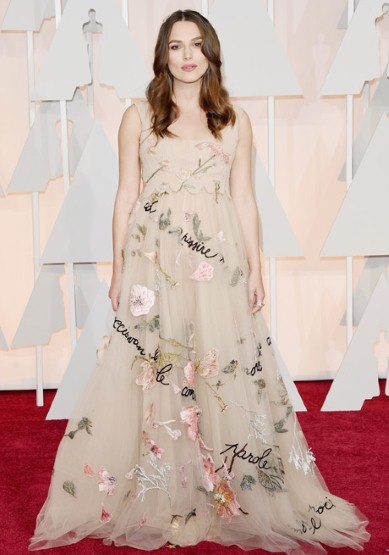
This was nowhere more sharply defined than in the choices made by mums-to-be Keira Knightley and Sophie Hunter. This was pregnancy dressed, two ways. Keira has had issues dressing a growing pregnancy body, veering from an overly fussy Chanel Couture at the Globes to a sweet but underwhelming purple gown at the SAG Awards. Knightley decided to side-step the slinky option and went for full-on romance in an exquisitely embroidered gown by Valentino. Covered in floral appliqué, this dress was stress-free, with minimal alterations required. Keira struck just the right note of sweetly demure, the gentle look playing well with her delicate features.
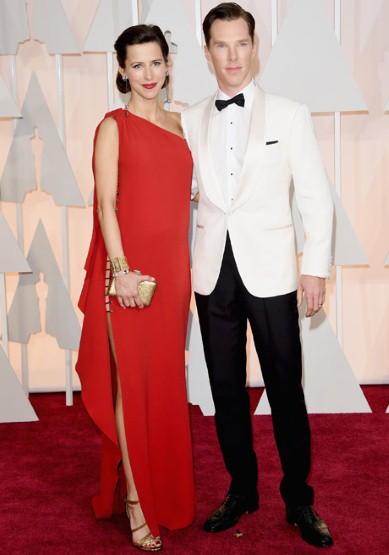
Sophie Hunter, however, went for Parisian drama in a draped scarlet gown by Lanvin. Neatly accessorised with a positively-beaming Benedict Cumberbatch, Sophie played it cool. Gone are the days of spouses and partners dressing down – Matthew McConaughey’s wife Camila Alves raised the stakes last year in her superlative red-carpet tour, turning up in one knock-out design after another. Camila’s approach to red-carpet dressing has changed the game for plus-ones: there’s no hiding away in a LBD anymore.
This was an Oscars that saw the return of many familiar friends. After a few seasons out in the cold, the classic ballgown silhouette returned in force with Felicity Jones, Lady Gaga and Jennifer Lopez giving us drama – and volume – for days. While Lady Gaga got some heat for pairing her stunning Alaia gown with red gloves, Jennifer Lopez went all-out with the romance in an Elie Saab gown that was perfectly in sync with her skin-tone. While there was too much cleavage on display (for some), the delicate bead-work made this one of my favourite choices for Lopez, who every now and again likes to remind us that she can do elegance really, really well.
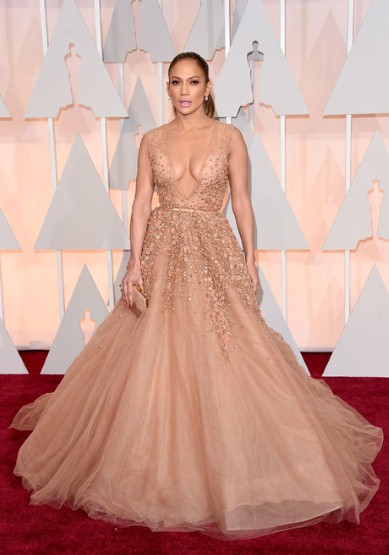
But if ballgowns aren’t your thing, and you still like a bit of tradition on the red-carpet, the beaded sheath dress returned, this time adding colour into the mix.

Emma Stone’s custom gown by Elie Saab was a perfect case in point. Wearing a notoriously hard colour, Emma’s chartreuse gown would be a complexion-draining nightmare for 99.9% of the population. But with Stone’s fair skin and red hair, Elie Saab got the shade exactly right. Emma’s gown managed to be both classic and modern; the backless beaded sheath was Hollywood 101, while the daring use of colour could not have been more contemporary if it tried.
Classic glamour paired itself with many of the big winners, including Best Actress Julianne Moore who won her first Oscar in a head-to-toe stunner from Chanel Couture.
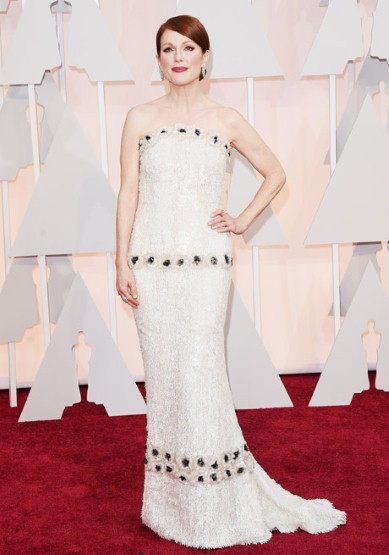
The vital statistics of this dress are dizzying. In total, the dress took 27 workers at Chanel 927 hours to make. Nine-hundred and twenty-seven hours. That equates to a month-and-a-half of solid sewing. Created from organza, this dress boasted 80,000 hand-painted resin sequins and flowers – all of course sewn on by hand.
Despite its impressive pedigree, this custom design with its Twenties drop-waist has meant this couture beauty hasn’t been everyone’s favourite. But I will attempt to convert you.
This is a dress designed specifically for the red-carpet; made for the close scrutiny of the camera. Google this gown on http://www.vogue.co.uk and look at it up close, and the detail is what brings the dress to life. Worked on by the best in the business, this is couture magnified. Karl Lagerfeld reminds us to not just take in the picture as a whole, but take time to appreciate the effort and workmanship it takes to bring something like this to fruition. Nuance isn’t just reserved for the big screen – high fashion also needs time and consideration to fulfil its potential. If you weren’t feeling it for Julianne’s custom Chanel, get a closer look and I promise that even if you still don’t love it, you will begin to appreciate it.
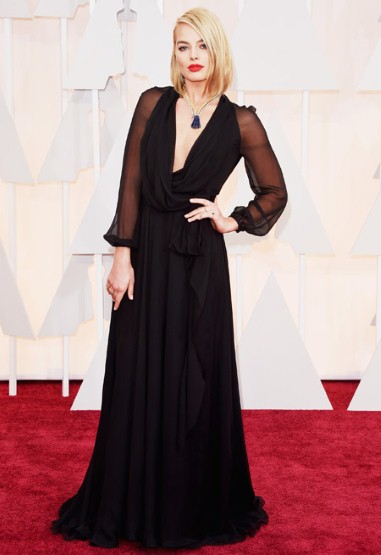
While romance scooped many of the headlines, for my money the best looks of the night were pared-back, minimal with a single killer detail.
My personal choice for Best Dressed was ‘Wolf of Wall Street’ star Margot Robbie. Wearing a black, long-sleeved chiffon gown from Saint Laurent, Margot accessorised the retro look with a $1.5 million Van Cleef and Arpels diamond necklace (originally designed for the Duchess of Windsor) – but the editorial edge came from Margot’s beauty styling. Debuting a new, shorter bob and adding a classic note with red lipstick, on a night where natural and glowy set the pace, Margot set herself apart in bold, dramatic style.
While I opted for Margot Robbie as Best Dressed, the verdict now seems to rest with ’50 Shades of Grey’ star Dakota Johnson who also impressed in a red gown from Saint Laurent. A one-shouldered creation with a jewelled knotted detail on the tip of the shoulder, this gown was a feat of engineering – nothing drooped, nothing puckered – everything stayed put. Saint Laurent has to be congratulated for coming up with a gown that exudes discipline, worn by the star of the most notorious film of the year. The dress was undeniably beautiful, and Dakota deserved her spot in the Best Dressed lists, but it was the construction of this gown that needed a round of applause.
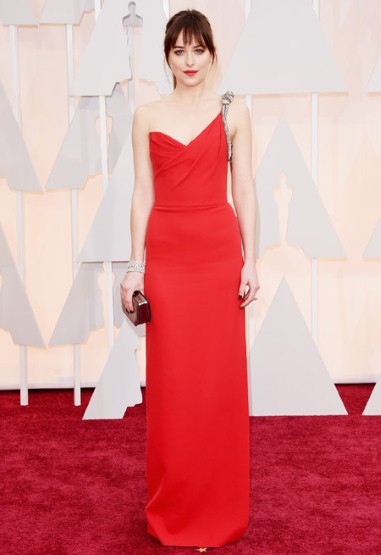
The night was not without controversy, but for once, this wasn’t a risqué hemline or sheer panel that raised eyebrows (although Rita Ora’s after-party frock came pretty close).
You may want to check the weather report as I am about to disagree with Reese Witherspoon, and hell might indeed have frozen over. The campaign to get red-carpet pundits to #askhermore, which Witherspoon supported, while well-intentioned, proved somewhat disingenuous. Yes, a woman’s success at the Oscars is largely measured by what she’s wearing. Yes, a man’s Oscar profile isn’t measured in the same way, and yes, it is blatantly sexist and extremely unfair.
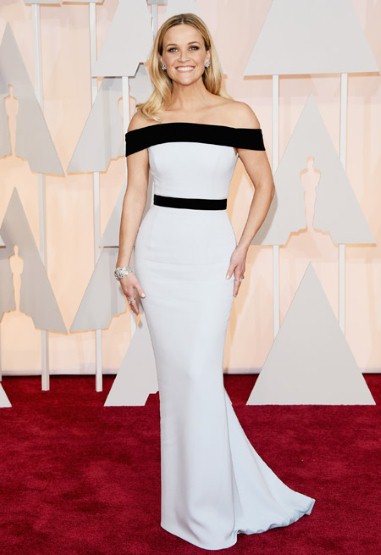
But the red-carpet game, however superficial you might think it is, is played by everyone. The smart cookies wear something that not only indicates where they are now in their career, but where they see themselves in 5 years’ time. The Oscars is basically the world’s glitziest job interview – and there are no exceptions. If you turn up, you’re taking part. Witherspoon, being one of Hollywood’s smartest cookies, understands this concept very well. Her black and white gown by Tom Ford may have looked like a deliberately-subdued choice, but with the expert tailoring from Ford, this gown was undeniably Brand Witherspoon: sophisticated, elegant and always the right side of sexy. Witherspoon never sells herself short; she’s a regular on the Best Dressed lists, but we all know that those fabulous red-carpet choices come packaged with a woman whose intelligence and wit make her no-one’s fool. There’s no need to #askhermore with Reese – she’s already giving you everything she’s got.
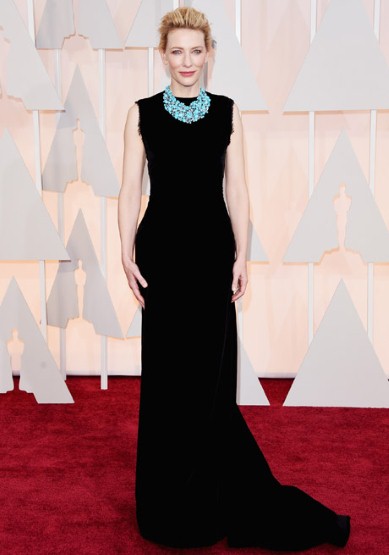
While it got a bit political over womenswear, the receding popularity of the classic tuxedo pushed menswear into the spotlight too. Though nominees Ethan Hawke and Michael Keaton went for the black tux (and nothing wrong with that), Benedict Cumberbatch, Jared Leto and Eddie Redmayne all opted for a fresh look at the tuxedo. Cumberbatch channelled honeymoon chic in an impeccably-tailored white jacket while Eddie won the gold in a navy tux from McQueen that worked brilliantly with his colouring. This growing trend to depart from the classic tuxedo is creating a genuine buzz around menswear – there will always be those who just feel more comfortable going classic – but for the boys who like their fashion, this is definitely the time to look around and explore. Expect to see this trend emerge in greater detail in Awards Season 2016.

So with the Oscars comes the end of the Awards Season for this year. It’s always difficult to sum up the ‘theme’ of an Awards Season, as there are so many variables. But 2015, if I had to pin it down, has to be the year where real choice and diversity made itself known. Menswear has gone from classic across the board, to nominees wearing colour and texture with confidence and flair. Womenswear has become more difficult to narrow down into a coherent ‘look’ and while that makes my job harder, this means that stars are now approaching red-carpet dressing with the same individuality they would apply to real life. The sure-fire route to Best Dressed is no longer such a clearly defined path. The sparkles, the dazzle are not always the way to impress: Best Dressed is no longer about being impeccable – it’s about being individual. While we will continue to ask ‘Who are you wearing?’, it’s becoming self-evident that our expectations are changing. We want to see the person behind the label – and gradually, Hollywood is getting the memo.
HELEN TOPE
